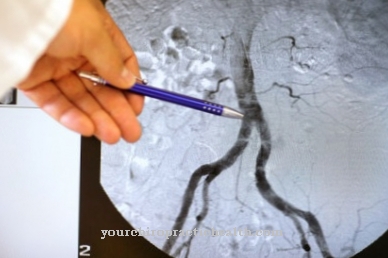The metabolic syndrome consists of four different factors: high blood pressure, obesity, insulin resistance and a change in blood lipid levels. If all four factors occur together, they pose a great risk for coronary heart disease.
What is Metabolic Syndrome?

© bilderzwerg - stock.adobe.com
The metabolic syndrome is not defined uniformly in Germany. The disease is mostly assigned either to insulin resistance or to complaints that arise from lifestyle. In the end, the metabolic syndrome is a combination of several diseases, some of which occur individually:
High blood pressure, being overweight, insulin resistance and a change in blood lipid levels. This "deadly quartet", as the metabolic syndrome is also known, is often responsible for coronary heart disease. The official definition of metabolic syndrome has changed several times in recent years.
causes
The causes of a metabolic syndrome mainly lie in a bad and unhealthy lifestyle. Too little exercise with too much or poor nutrition are the main factors. All four diseases are so-called affluence diseases that affect many people in Western cultures.
But there are also other factors. For example, a genetic predisposition is relevant to obesity. Medicines can also play a role. Other diseases, such as an underactive thyroid, can also cause obesity. The causes of high blood pressure can be hormonal disorders, kidney damage or disorders of the cardiovascular system.
Most of the time, the actual causes are in the dark. Insulin resistance has to do with a genetic metabolic disorder. The main cause of the metabolic syndrome, however, remains an unhealthy lifestyle.
Symptoms, ailments & signs
The metabolic syndrome manifests itself in clinical pictures such as obesity, high blood pressure, lipid metabolism disorders, and increased blood sugar. Those affected often notice signs of obesity first, with the excess weight being concentrated in the abdomen.
This is accompanied by symptoms such as abdominal pain, shortness of breath or tightness of the chest. High blood pressure manifests itself, among other things, through symptoms such as headache, breast stinging, pain in the limbs and persistent restlessness. A lipid metabolism disorder leads to diabetes, which manifests itself among other things as a strong feeling of thirst, pronounced urge to urinate and impaired vision.
Diabetes patients are also often exhausted and repeatedly suffer from nausea and vomiting as well as unspecific itching on the skin. Lipid metabolism disorders often only become noticeable as a result of vascular calcification. Outwardly, they can be recognized by the typical fat nodules on the hands, feet, eyelids and buttocks.
Every third person suffering from the metabolic syndrome has sleep apnea, which manifests itself in nightly breathing pauses and the resulting exhaustion and fatigue. The metabolic syndrome develops over months or years and is often only recognized when serious health problems have already arisen. Risk factors such as obesity or high blood pressure therefore always require a medical examination.
Diagnosis & course

The four individual diseases of metabolic syndrome are mostly diagnosed individually. One speaks of being overweight when the body mass index is over 25. Obesity, i.e. pathological overweight, begins with a body mass index of 30. The more overweight, the greater the risks for secondary diseases.
The doctor diagnoses arterial hypertension, i.e. high blood pressure, primarily by measuring blood pressure. If the hypertension is left untreated, heart disease, arteriosclerosis and other organ damage can result. The first suspicion of insulin resistance is often a high body weight. Insulin resistance is present in all patients with type II diabetes. If left untreated, diabetes leads to severe organ damage.
Changes in blood lipid levels are determined by a blood test. If all four diseases occur together, a metabolic syndrome is diagnosed. If all four clinical pictures remain, the risk of coronary heart disease is very high. Arrhythmias, myocardial infarction and sudden cardiac death can be the consequences of metabolic syndrome.
Complications
With this syndrome, people usually suffer from various ailments. In most cases this leads to obesity and thus also to high blood pressure. The affected person can also die of a heart attack if treatment for the disease is not initiated. Furthermore, there is a shortage of breath, so that the resilience of the person affected is significantly reduced. There is tiredness and fatigue.
It is not uncommon for the patient's metabolism to be disturbed, so that the consumption of food leads to pain. Patients can also die from sudden cardiac death. This syndrome significantly reduces life expectancy. Furthermore, being overweight leads to various restrictions in the life of the patents. Diabetes can lead to various types of damage to the internal organs and reduce life expectancy even further.
Treatment of this syndrome can be done with the help of medication. There are usually no complications. However, those affected also have to give up alcohol or cigarettes and are dependent on a strict diet. In many cases, most complaints can be limited in this way.
When should you go to the doctor?
People who are overweight, have high blood pressure, lipid metabolism disorders or diabetes should consult a doctor regularly in the run-up to a metabolic syndrome. The whole purpose of this measure is to prevent metabolic syndrome as much as possible. The metabolic syndrome does not cause any pain or significant discomfort. As a result, its development often goes unnoticed.
If a metabolic syndrome has already been diagnosed, regular visits to the doctor are even more important. The metabolic syndrome can lead to serious complications, for example cardiovascular diseases. It is important to prevent this development. It is counteracted with suitable measures. For example, your doctor may recommend a diet aimed at lowering blood lipid and cholesterol levels.
High blood pressure and diabetes must be monitored to keep them stable. If necessary, drug treatment must be initiated. If there is a suspicion of a genetic increase in certain blood values, appropriate examinations must be carried out. This can be, for example, LDL cholesterol or a specific lipo-protein. If necessary, these can be removed by apheresis.
The doctor may send people to see a nutritionist. The diet must be adapted to the metabolic syndrome. The necessary diet measures can also be monitored by a doctor. The doctor may also advise you to exercise more. In support of this, the person affected can be advised to undergo behavioral therapy.
Treatment & Therapy
Treating a metabolic syndrome mostly occurs through a change in lifestyle. But here, too, a distinction must be made between the four clinical pictures: Obesity should be gradually reduced through more exercise and a change in diet.
There are various models for this, some of which are supported by health insurance companies. Insulin resistance is also treated by getting more exercise and reducing your daily calorie intake. In addition, high doses of insulin are sometimes prescribed to break the cycle of insulin resistance. Medicines are usually prescribed for high blood pressure that are supposed to normalize blood pressure values.
In addition, here too, the patient has to change his lifestyle in order to get the disease under control. Patients are advised to quit smoking, exercise more, and lose excess weight. The patient should also change their lifestyle in the case of lipid metabolism disorders that change blood lipid levels.
In some cases, the vitamin D intake is increased in patients with a metabolic syndrome. The therapy of the metabolic syndrome should also include detailed patient advice. In this consultation, he is informed about the risks of his illness and receives assistance in changing his lifestyle.
Outlook & forecast
The prognosis of the metabolic syndrome depends on the individual characteristics of the disorders present. In the event of an unfavorable course of the disease, all existing irregularities occur together. These lead to a life-threatening condition. This can lead to premature death and an unfavorable prognosis. The disease is made up of four different factors. The fewer of these factors are shown, the better the prospect is usually.
How the patient's cooperation is designed for a change is also decisive for the course of development. The lifestyle must be optimized immediately and adapted to the natural needs of the organism. In addition, the weight must be kept within the normal range of the BMI. An unhealthy lifestyle due to the ingestion of pollutants and a lack of exercise lead to an increase in complaints and thus to a critical condition.
With an early diagnosis and an immediate change in lifestyle by the person affected, the further prospects improve. Recovery from metabolic syndrome is possible. For this, in addition to medical care, a change in everyday processes is imperative. Long-term freedom from symptoms can only be achieved through permanent changes in diet, a diet rich in vitamins and the avoidance of alcohol and nicotine.
prevention
There a metabolic syndrome primarily has to do with lifestyle, a healthy lifestyle is the best preventative measure. This includes a diet that is high in fruit, vegetables and whole grain products, but low in sugar. Regular exercise is also important. On the other hand, smoking and excessive alcohol consumption should be avoided. With these basic rules, anyone can effectively prevent metabolic syndrome and minimize the risk of coronary heart disease.
Aftercare
After chronic high blood pressure is relieved, patients often feel tired, exhausted, and exhausted. Since the metabolic syndrome is a complex clinical picture in which various complications can arise, aftercare is primarily directed towards preventing the condition from worsening.
The occurring lipid metabolism disorders, increased blood sugar levels and high blood pressure are countered with appropriate medication. The prescribed medication can cause side effects such as gastrointestinal complaints or skin changes. Like preventive care, follow-up care focuses on averting the causes of the metabolic syndrome in the long term by paying attention to which factors promote the disease.
You can do that yourself
Those affected can treat metabolic syndrome themselves by changing their lifestyle. Depending on the clinical picture, for example, weight must then be reduced or regular exercise integrated into everyday life. The sick should have a medical check-up beforehand in order to rule out cardiovascular problems and other diseases.
An adjustment of the diet is usually also necessary, because only building healthy eating habits and avoiding unhealthy food and drinks can protect against long-term effects. A low-calorie and low-fat mixed diet consisting of fiber and complex carbohydrates is recommended. Individual advice from a doctor or a nutritionist makes it easier to put together a suitable nutrition plan. The patient should also avoid stimulants. Smoking and alcohol are not recommended in the case of metabolic syndrome, as this will only cause further health problems in case of doubt. Patients taking medication should, in consultation with the doctor, adapt the medication to the new lifestyle so that the metabolic syndrome can be reduced as freely as possible.
If the symptoms do not subside, it is best to inform the doctor responsible. Concomitant drug treatment or other therapy may then be necessary.












.jpg)



.jpg)










.jpg)
